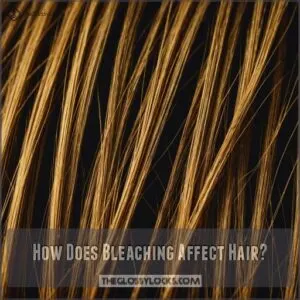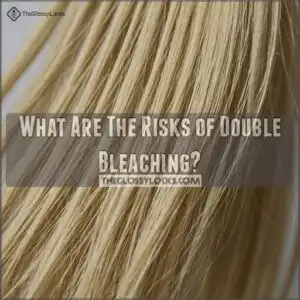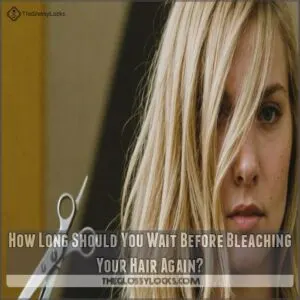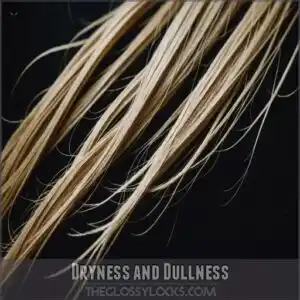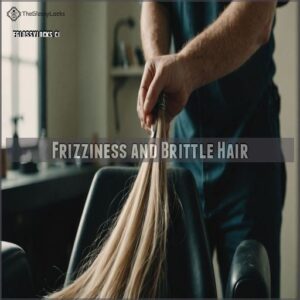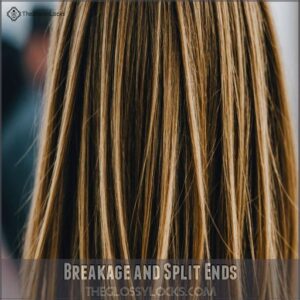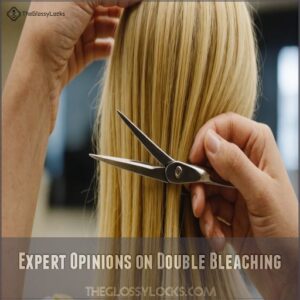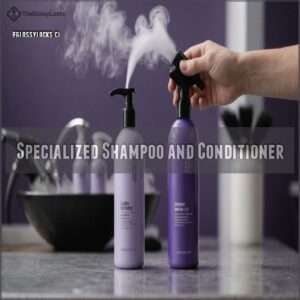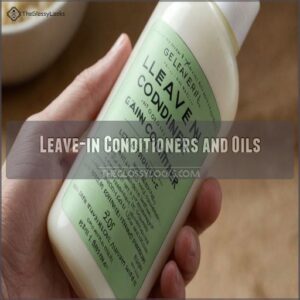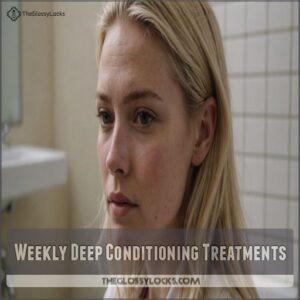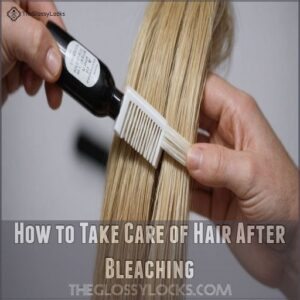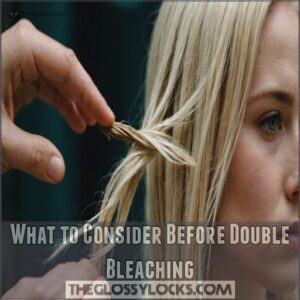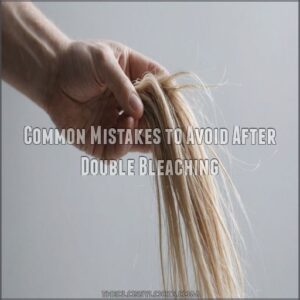This site is supported by our readers. We may earn a commission, at no cost to you, if you purchase through links.
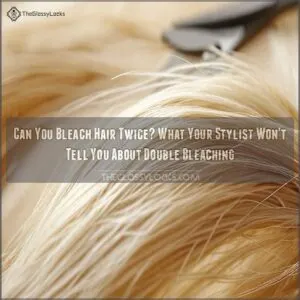 Yes, you can bleach hair twice, but it’s like asking your hair to run two marathons back-to-back – risky business!
Yes, you can bleach hair twice, but it’s like asking your hair to run two marathons back-to-back – risky business!
While double bleaching might be necessary for darker hair to reach that perfect platinum, you’ll need to wait at least 2-3 weeks between sessions.
Your hair’s natural defenses get stripped away with each bleaching, so timing is everything.
Professional stylists recommend a thorough assessment of your hair’s health before attempting round two.
Think of your hair like a silk scarf – treat it right, and it’ll stay beautiful; rush the process, and you might end up with something that resembles crispy ramen noodles.
Table Of Contents
- Key Takeaways
- How Does Bleaching Affect Hair?
- Can You Bleach Hair Twice in a Day?
- What Are The Risks of Double Bleaching?
- How Long Should You Wait Before Bleaching Your Hair Again?
- Signs of Bleach Damage
- Expert Opinions on Double Bleaching
- Caring for Bleached Hair
- How to Take Care of Hair After Bleaching
- What to Consider Before Double Bleaching
- Common Mistakes to Avoid After Double Bleaching
- Frequently Asked Questions (FAQs)
- Can I bleach my hair twice in a row?
- How often should one wash their hair for excessive hair growth?
- Should I bleach my hair a second time?
- What happens if you bleach your hair twice in one day?
- How often should I bleach my hair?
- Should I bleach my hair?
- How long do I have to wait to bleach my hair again?
- Should I bleach my hair again if it turned orange?
- How to fix uneven bleached hair?
- How to double process bleach hair?
- Does toner affect the timing between bleach sessions?
- Can certain medications interfere with hair bleaching results?
- What role does hair porosity play in bleaching?
- Is bleaching damp hair better than dry hair?
- Do natural hair colors respond differently to bleaching?
- Conclusion
Key Takeaways
- You can bleach your hair twice, but wait at least two to three weeks between sessions to prevent severe damage and breakage.
- Bleaching strips away natural oils and lifts cuticles, making hair brittle, dry, and more porous, increasing vulnerability to damage.
- Always consult a professional before a second bleaching to assess your hair’s health and consider gentler alternatives like a bleach bath.
- Proper aftercare, like deep conditioning, avoiding heat styling, and using protective products, is crucial to maintain your hair’s health and integrity.
How Does Bleaching Affect Hair?
You might think bleaching just lightens your hair, but it’s actually opening up tiny doors in your strands and breaking down the natural color molecules inside.
While using a hair treatment rich in omega-7 fatty acids for hair elasticity can help restore hair’s natural protective barriers, this process can give you that dreamy blonde you’re after, it’s also stripping away your hair’s natural oils and protective barriers, which is why you’ll need to give it some extra TLC afterward.
Chemical Processes Involved
Ever wonder what’s happening when bleach hits your hair? The science behind it’s pretty wild. Your hair goes through three major changes:
- Hydrogen peroxide breaks down your natural melanin (that’s what gives your hair its color)
- The chemicals lift those color molecules right out of your hair shaft
- An oxidation process kicks in, permanently altering your hair’s structure
Think of it like stripping paint from a wall – once it’s done, there’s no going back.
Damage to Hair Cuticles
Beyond those chemical reactions, bleaching wreaks havoc on your hair’s protective outer layer – the cuticles.
Think of these tiny scales like roof shingles protecting your hair.
When bleach hits them, they lift and separate, leaving your strands vulnerable.
Once damaged, these cuticles can’t lay flat again, making your hair feel rough and look dull.
It’s like leaving your roof’s shingles permanently lifted during a storm.
To minimize damage from repeated bleaching, like a third bleaching session, it’s important to wait 8-10 weeks between sessions and use a suitable developer volume for bleaching.
Loss of Natural Oils
Your hair’s natural oils are like a protective shield, keeping strands healthy and moisturized.
When you bleach, these oils get stripped away, leaving your hair vulnerable.
Think of it like washing your face with harsh soap – your skin feels tight and dry afterward.
To combat this, you’ll need to replace those lost oils with deep conditioning treatments and moisturizing products until your scalp catches up.
Can You Bleach Hair Twice in a Day?
The temptation to double bleach can feel like an itch you’re dying to scratch.
But here’s the truth: while it’s technically possible to bleach your hair twice in one day, most professionals strongly advise against it.
Think of your hair like a delicate fabric – each bleaching session weakens its structure considerably.
If you’re looking for a gentler alternative, you might consider a bleach bath recipe that can lift 1-2 levels of color.
If you’re determined to go lighter, consider working with a professional who might suggest alternatives like a gentler bleach bath or soap cap method.
They’ll know exactly how to achieve your desired results without compromising your hair’s integrity.
What Are The Risks of Double Bleaching?
You’ve probably heard that double bleaching can make your hair lighter faster, but it’s not as simple as slapping on more bleach.
Your hair’s protective outer layer takes a serious hit with each bleach session, putting you at risk for breakage, extreme dryness, and that dreaded cotton candy texture that’s impossible to style.
Over-processing and Breakage
When you bleach your hair twice, each application weakens the protein bonds holding your strands together.
Think of it like repeatedly stretching a rubber band – eventually it snaps.
Over-processing can leave you with broken strands that look like confetti on your shoulders.
Split ends are a natural part of hair aging that can be minimized through regular hair care routine. Even worse, those split ends will keep traveling up your hair shaft, leading to widespread breakage that’s nearly impossible to reverse.
Dryness and Brittle Hair
Double bleaching strips away natural oils like a desert sun, leaving your strands thirsty and brittle.
Think of it as putting your hair through a washing machine twice – it’ll come out feeling like straw.
Hair masks and protein treatments become your new best friends, fighting that straw-like texture.
Without proper care, those precious strands will snap faster than uncooked spaghetti, making split ends your constant companion.
Increased Porosity
Repeatedly bleaching your hair dramatically increases its porosity, making it act like a thirsty sponge that soaks up everything – including stuff you don’t want.
Your strands become more vulnerable to moisture loss and protein imbalances, leading to that dreaded frizzy, tangled mess.
Think of porosity like tiny holes in your hair’s shield – the more you bleach, the bigger these gaps become, leaving your locks defenseless against damage.
How Long Should You Wait Before Bleaching Your Hair Again?
If you’re itching to lighten your locks again, you’ll need to hit the brakes for at least two weeks to protect your hair from serious damage.
This recovery time lets your hair rebuild its strength and natural moisture balance.
While waiting can feel like watching paint dry when you’re excited about your next hair transformation, this recovery time lets your hair rebuild its strength and natural moisture balance.
Recommended Timeframe
The safest bet for your hair’s well-being is waiting 14 days between bleach sessions.
Think of it like giving your hair a vacation – it needs time to bounce back.
While some stylists suggest 3-8 weeks as the sweet spot, the gold standard is a minimum two-week break.
Your scalp and strands will thank you by staying stronger and healthier during the lightening journey.
Factors Affecting Waiting Time
Several factors shape how long you’ll need to wait between bleaching sessions. Your unique hair journey affects the timeline:
- Natural hair color and texture determine how easily pigment lifts
- Previous chemical treatments can make your strands more sensitive
- Bleach strength used in your last session, which is often determined by the ratio of bleach to developer, impacts waiting time
- Current hair porosity influences how your locks will react
Think of it like letting your favorite jeans fade naturally – some things just can’t be rushed.
Importance of Hair Recovery
Between bleaching sessions, your hair needs time to rebuild its strength and elasticity.
Think of it like taking a break after an intense workout – your hair’s protein bonds and natural moisture levels need time to recover.
During this healing period, your scalp produces oils that help repair and protect your strands.
Rushing into another bleaching session too soon is like throwing your hair under the bus.
Signs of Bleach Damage
If you’ve noticed your hair feeling like straw and looking as dull as your Monday mornings, you’re probably dealing with bleach damage.
Your once-silky strands might also be breaking off faster than you can say "oops," which means it’s time to spot these warning signs before you reach for that bleach bottle again.
Dryness and Dullness
Double-bleached hair often looks like straw left out in the desert – dry and lifeless.
You’ll notice your once-silky strands feeling rough to the touch and looking disappointingly matte.
Without its natural oils stripped away by harsh chemicals, your hair loses its ability to reflect light properly.
Products for bleach damage repair can be especially helpful in restoring some of the lost moisture.
Deep conditioning masks and leave-in treatments can help restore some shine, but prevention is key when it comes to bleach damage.
Frizziness and Brittle Hair
That dull, lifeless look isn’t the only sign your bleached hair’s crying for help.
You’ll notice your once-smooth strands becoming increasingly unruly, like a rebellious teenager testing boundaries.
When hair turns brittle, it loses its natural elasticity and becomes as fragile as thin glass.
Think of your hair like a delicate silk scarf – bleaching twice makes it stiff and prone to standing on end.
Breakage and Split Ends
After intense bleaching, you’ll notice your hair snapping off like brittle twigs – that’s the telltale sign of severe breakage.
Your once-smooth strands might develop split ends that climb up the hair shaft, looking like frayed rope ends, especially if you’ve been neglecting to use a heat protectant for burnt hair.
When your hair loses its elasticity and starts breaking at the mere touch of a brush, it’s crying out for help.
Don’t ignore these warning signs of over-processing.
Expert Opinions on Double Bleaching
You’ll want to hear what hair experts really think about bleaching your hair twice, and trust me, their insights might surprise you.
While some pros say it’s possible with the right precautions, many top stylists and organizations like The Trichology Society warn that double bleaching can seriously damage your locks.
Karen Marie Shelton’s Advice
While examining your damaged strands might feel disheartening, you should keep in mind the chemical reactions involved in the lightening process, such as the oxidative process that breaks down color molecules using hydrogen peroxide reactions.
Once you’ve bleached your hair, you’ve already altered its natural state, she warns.
Her advice? Think twice before going for that second round of lightening.
Mel McCully’s Recommendations
Expert stylist Mel McCully suggests a gentler approach if you’re set on double bleaching – try a soap cap (bleach mixed with shampoo).
You’ll get lighter results without destroying your hair’s structure.
"It’s like giving your hair a breather between rounds," she explains.
Just remember to monitor your hair’s condition closely and stop if you notice any signs of damage.
Versions Vividamnesia’s Insights
Master Hair colorist Versions Vividamnesia brings a fresh perspective to double bleaching, noting it’s possible on healthy hair.
She emphasizes starting with completely dry hair for the best results – think desert-dry, not even a hint of dampness.
While some stylists shy away from the technique, Vividamnesia’s approach focuses on proper preparation and timing rather than outright dismissal of double processing.
The Trichology Society’s Warning
You might think professional hair scientists are being overly cautious, but The Trichology Society’s research paints a stark picture.
Their studies reveal three main concerns with double bleaching:
- Severe protein loss leading to structural collapse
- Irreversible cuticle damage that can’t be repaired
- Permanent alterations to your hair’s natural moisture balance
That’s why they strongly advise against double bleaching, no matter how tempting it might be.
Caring for Bleached Hair
If your stylist has recommended a toner application after bleaching, knowing the right amount of product is crucial – for instance, using 2 ounces of toner for long bleached hair how many ounces of toner, If you’ve taken the plunge into blonde territory, your bleached hair needs some serious TLC to stay healthy and strong.
You’ll need to switch up your hair care routine with specialized products and treatments that’ll keep your newly lightened locks from turning into a brittle, straw-like mess.
Specialized Shampoo and Conditioner
Picking up the right shampoo and conditioner for bleached hair feels like going through a beauty maze.
Here’s a straightforward guide to help you choose what works best:
| Product Type | Key Ingredients | Best For |
|---|---|---|
| Sulfate-free | Keratin, Biotin | Daily Use |
| Purple/Silver | Violet Pigments | Toning |
| Bond-Building | Olaplex, Protein | Repair |
| Moisturizing | Glycerin, Aloe | Hydration |
| Clarifying | ACV, Charcoal | Monthly Deep Clean |
Leave-in Conditioners and Oils
Beyond your daily shampoo routine, bleached hair craves extra nourishment.
Think of leave-in conditioners as your hair’s daily multivitamin – they keep working long after you’ve styled your locks.
You can also find various argan oil products for bleached hair online, such as on websites dedicated to argan oil for bleached hair.
Natural oils like argan, coconut, or jojoba can be your secret weapon against dryness.
Apply them to damp hair, focusing on the ends. Don’t worry about looking greasy; a little goes a long way.
Weekly Deep Conditioning Treatments
While oils work wonders for daily care, deep conditioning treatments are your weekly power move.
Think of them as a mini spa day for your bleached strands – they’ll restore moisture and strength from the inside out.
Set aside 20-30 minutes every weekend, apply your favorite deep conditioner, wrap your hair in a warm towel, and let those nutrients work their magic.
How to Take Care of Hair After Bleaching
You’ll need to treat your bleached hair like it’s your most expensive cashmere sweater – with extra TLC and the right products to keep it healthy.
Bleached hair requires special care to keep it healthy.
The good news is that with proper care techniques, you can maintain your lighter locks without turning them into a brittle mess.
Choosing Gentle Products
Your bleached locks deserve products that treat them like royalty.
After investing time and money in that perfect blonde, you’ll want gentle formulas that maintain your hair’s health and vibrancy.
Here’s what your product arsenal needs:
- Sulfate-free shampoo designed for color-treated hair
- Protein-rich conditioner to rebuild strength
- Leave-in treatment with natural oils for moisture retention
Think of these products as your hair’s personal bodyguards against further damage.
Avoiding Excessive Heat Styling
After picking gentle products, let’s talk about those hot tools gathering dust on your counter.
Think twice before reaching for that flat iron – bleached hair’s already fragile enough!
Stick to air-drying whenever possible, or use your blow dryer on its coolest setting.
When you absolutely need to style, always use heat protection products first.
Try heatless alternatives like overnight braids or sock curls for gorgeous waves.
Protecting Hair From The Sun
During sunny days, bleached hair needs extra TLC since UV rays can turn your carefully crafted color into a brassy nightmare.
Think of your hair like delicate silk – it needs protection from harsh elements.
Here’s how to shield those precious strands:
- Wear a wide-brimmed hat or stylish cap
- Use leave-in products with UV filters
- Apply hair-specific sunscreen spray
- Keep hair covered with a silk scarf when poolside
What to Consider Before Double Bleaching
Before you grab that second box of bleach, you’ll want to check if your hair’s ready for another round by examining its current condition and getting a pro’s opinion.
Your natural hair color, which can be enhanced or altered using natural ingredients like carrot juice hair dye, plays a huge role in how many bleaching sessions you’ll need, so understanding your starting point will help you avoid that dreaded orange or patchy result.
Checking Hair Condition
Before jumping into another round of bleach, take a close look at your hair’s condition.
Run your fingers through it – if it feels like straw or snaps easily, that’s a red flag, and you might want to assess if your hair is dry or damaged using the hair strand test.
Try the stretch test: grab a wet strand and gently pull. Healthy hair bounces back, while damaged hair breaks.
Check your scalp too – any burning, redness, or tenderness means you should pump the brakes.
Consulting a Hair Expert
Sitting down with a professional colorist isn’t just about getting their stamp of approval – it’s your chance to get a personalized game plan.
They’ll assess your hair’s health, previous chemical treatments, and lifestyle factors that could impact your results.
To help with damage control, they may recommend hair repair solutions.
Think of them as your hair’s personal detective, spotting potential issues before they become problems.
Plus, they can recommend specific products and treatments to keep your locks healthy.
Considering Natural Pigment
Your natural hair color holds the key to successful bleaching.
Like a roadmap, your pigment level guides the whole process.
Here’s what determines how your hair will react:
- Darker hair needs multiple sessions to reach platinum blonde safely
- Red pigments are the most stubborn to remove, often leaving brassy tones
- Virgin hair lifts more predictably than previously processed hair
Choose your bleaching strategy based on these factors.
Common Mistakes to Avoid After Double Bleaching
You’ve taken the bold step of double bleaching your hair, but now you’re walking on eggshells trying not to mess it up.
While your newly lightened locks might feel like they need extra attention, there are some common post-bleaching habits that can turn your hair transformation into a disaster.
Overwashing and Using High-Heat Tools
Two common mistakes can wreck your freshly bleached hair faster than you’d think.
Overwashing strips away those precious natural oils your delicate strands desperately need, while cranking up the heat on styling tools is like throwing gasoline on a fire.
Think of your bleached hair as fine silk – it needs gentle handling.
Instead of daily washing, try dry shampoo between washes to keep your style fresh.
When you do style, dial down the heat settings to the lowest effective temperature.
Remember, bleached hair is already stressed, so treat it like the delicate treasure it is.
Skipping Conditioning and Neglecting Heat Protection
Beyond steering clear of hot tools, there’s another common trap that’ll wreak havoc on your bleached hair.
Here’s a secret from pro stylists: skipping conditioner after bleaching isn’t just bad – it’s like leaving your hair out in the desert without water. Think your hair feels dry now? Without proper conditioning, you’re looking at a recipe for frizz city.
And speaking of protection, walking into a styling session without heat protectant is like heading to the beach without sunscreen. Double-bleached hair needs that extra barrier, or you’ll end up with more split ends than you can count.
Frequently Asked Questions (FAQs)
Can I bleach my hair twice in a row?
Professional hairstylists strongly advise against bleaching your hair twice in a row.
It’s best to wait at least 14 days between sessions to prevent severe damage, breakage, and potential hair loss.
Consider professional guidance instead.
How often should one wash their hair for excessive hair growth?
Don’t count your chickens before they hatch – washing frequency doesn’t directly boost hair growth.
You should wash your hair 2-3 times weekly to maintain a healthy scalp and natural oils.
Should I bleach my hair a second time?
You’ll want to wait at least 14 days between bleaching sessions to protect your hair’s health.
If you’re in a hurry, consider seeing a professional who can safely achieve your desired results.
What happens if you bleach your hair twice in one day?
Want your hair to fall apart like confetti?
Bleaching twice in one day can severely damage your strands, leading to breakage and brittleness.
Instead, wait at least 14 days between sessions for healthier results.
How often should I bleach my hair?
Wait 3-8 weeks between bleaching sessions to protect your hair’s health. For all-over bleaching, let new growth reach ½ inch, while highlights need about 1 inch of growth (6-8 weeks).
Should I bleach my hair?
Dreaming of a bold new look?
Consider your hair’s health and maintenance commitment before bleaching.
While it’s possible to achieve stunning results, bleaching can damage your hair and requires careful aftercare to maintain.
How long do I have to wait to bleach my hair again?
You’ll need to wait at least 14 days between bleach sessions to let your hair recover.
Pushing it sooner risks serious damage.
For best results, many pros recommend waiting 3-8 weeks between treatments.
Should I bleach my hair again if it turned orange?
If your hair turned orange, balance caution with action.
Use a toner or visit a professional rather than bleaching again immediately.
Over-bleaching risks damage.
Think of your hair as a garden; nurture, don’t over-prune.
How to fix uneven bleached hair?
Uneven bleach? Don’t panic! A toner can even out the color. Or, try a gloss to blend things. A professional can also help you fix it.
How to double process bleach hair?
Double-processing bleach involves applying bleach, rinsing, and reapplying to achieve a lighter shade.
Make sure your hair is healthy, and use a professional colorist to minimize damage and maintain hair integrity with proper care afterward.
Does toner affect the timing between bleach sessions?
Think of toner as a pit stop for your hair; it won’t reset the clock between bleach sessions.
While it helps with color, your hair still needs time to recover from bleaching before you go again.
Can certain medications interfere with hair bleaching results?
Some medications can mess with hair bleaching results, causing unexpected colors or poor absorption.
Drugs like certain antibiotics or acne treatments may contribute to these surprises.
So it’s smart to chat with your stylist before bleaching.
What role does hair porosity play in bleaching?
Hair porosity affects how bleach penetrates your hair.
High porosity means your hair absorbs bleach quickly, risking damage.
Low porosity makes it harder for bleach to penetrate evenly, often requiring more product and time for results.
Is bleaching damp hair better than dry hair?
Bleaching dry hair often yields more consistent results, like painting on a blank canvas, as it guarantees even color absorption.
Wet hair, being more porous, might absorb too quickly, risking uneven tones and extra damage.
Do natural hair colors respond differently to bleaching?
Natural hair colors can bleach differently based on their shade and texture, as the bleach residue can affect color retention, depending on the porosity of the hair.
Lighter hair lifts easier, while darker shades might require more time or sessions.
Curly or coarse textures can also respond uniquely, needing careful handling.
Conclusion
Ultimately, deciding whether you can bleach your hair twice depends entirely on its condition.
Think of your hair like a delicate flower – it needs time to recover!
While double bleaching is possible, it’s a high-risk, high-reward situation.
Remember, patience is key. Give your hair at least two to three weeks between bleaching sessions.
Prioritize deep conditioning treatments, use gentle products, and avoid heat styling.
If you’re unsure, consult a professional stylist. They can assess your hair’s health and guide you on the best approach.
Remember, healthy hair is happy hair! So, before you even consider bleaching your hair twice, make sure you’re taking care of it properly.

